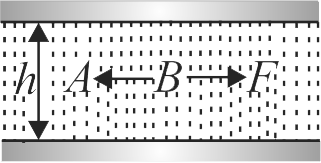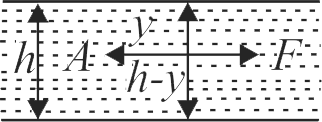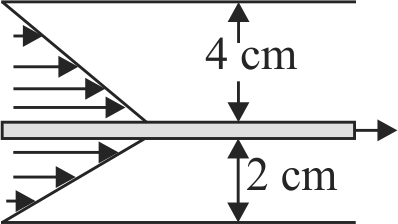361325
A thin plate \({A B}\) of large area \({A}\) is placed symmetrically in a small gap of height ' \({h}\) ' filled with water of viscosity \({\eta_{0}}\) and the plate has a constant velocity \({v}\) by applying a force \({F}\), as shown in the figure. If the gap is filled with some other liquid of viscosity \({0.75 \eta_{0}}\) where should the plate be placed in the gap, so that the plate can again be pulled at the same constant velocity \({V}\), by applying the same force \({F}\). (Take \({h=20 {~cm}}\))
361326
Viscous force is similar to friction in solids, but viscous force
I. Is independent of area but friction depends on area
II. Is temperature dependent while friction force between solids depends upon normal reaction
III. Is velocity dependent while friction is velocity independent
361327 The space between two large horizontal metal plates, \(6\,\;cm\) apart, is filled with a liquid of viscosity \(0.8\;N/{m^2}\). A thin plate of surface area \(0.01\;\,{m^2}\) is moved parallel to the length of the plate such that the plate is at a distance of \(2\;m\) from one of the plates and \(4\;cm\) from the other. If the plate moves with a constant speed of \(1\;m{s^{ - 1}}\), then
361325
A thin plate \({A B}\) of large area \({A}\) is placed symmetrically in a small gap of height ' \({h}\) ' filled with water of viscosity \({\eta_{0}}\) and the plate has a constant velocity \({v}\) by applying a force \({F}\), as shown in the figure. If the gap is filled with some other liquid of viscosity \({0.75 \eta_{0}}\) where should the plate be placed in the gap, so that the plate can again be pulled at the same constant velocity \({V}\), by applying the same force \({F}\). (Take \({h=20 {~cm}}\))
361326
Viscous force is similar to friction in solids, but viscous force
I. Is independent of area but friction depends on area
II. Is temperature dependent while friction force between solids depends upon normal reaction
III. Is velocity dependent while friction is velocity independent
361327 The space between two large horizontal metal plates, \(6\,\;cm\) apart, is filled with a liquid of viscosity \(0.8\;N/{m^2}\). A thin plate of surface area \(0.01\;\,{m^2}\) is moved parallel to the length of the plate such that the plate is at a distance of \(2\;m\) from one of the plates and \(4\;cm\) from the other. If the plate moves with a constant speed of \(1\;m{s^{ - 1}}\), then
361325
A thin plate \({A B}\) of large area \({A}\) is placed symmetrically in a small gap of height ' \({h}\) ' filled with water of viscosity \({\eta_{0}}\) and the plate has a constant velocity \({v}\) by applying a force \({F}\), as shown in the figure. If the gap is filled with some other liquid of viscosity \({0.75 \eta_{0}}\) where should the plate be placed in the gap, so that the plate can again be pulled at the same constant velocity \({V}\), by applying the same force \({F}\). (Take \({h=20 {~cm}}\))
361326
Viscous force is similar to friction in solids, but viscous force
I. Is independent of area but friction depends on area
II. Is temperature dependent while friction force between solids depends upon normal reaction
III. Is velocity dependent while friction is velocity independent
361327 The space between two large horizontal metal plates, \(6\,\;cm\) apart, is filled with a liquid of viscosity \(0.8\;N/{m^2}\). A thin plate of surface area \(0.01\;\,{m^2}\) is moved parallel to the length of the plate such that the plate is at a distance of \(2\;m\) from one of the plates and \(4\;cm\) from the other. If the plate moves with a constant speed of \(1\;m{s^{ - 1}}\), then
361325
A thin plate \({A B}\) of large area \({A}\) is placed symmetrically in a small gap of height ' \({h}\) ' filled with water of viscosity \({\eta_{0}}\) and the plate has a constant velocity \({v}\) by applying a force \({F}\), as shown in the figure. If the gap is filled with some other liquid of viscosity \({0.75 \eta_{0}}\) where should the plate be placed in the gap, so that the plate can again be pulled at the same constant velocity \({V}\), by applying the same force \({F}\). (Take \({h=20 {~cm}}\))
361326
Viscous force is similar to friction in solids, but viscous force
I. Is independent of area but friction depends on area
II. Is temperature dependent while friction force between solids depends upon normal reaction
III. Is velocity dependent while friction is velocity independent
361327 The space between two large horizontal metal plates, \(6\,\;cm\) apart, is filled with a liquid of viscosity \(0.8\;N/{m^2}\). A thin plate of surface area \(0.01\;\,{m^2}\) is moved parallel to the length of the plate such that the plate is at a distance of \(2\;m\) from one of the plates and \(4\;cm\) from the other. If the plate moves with a constant speed of \(1\;m{s^{ - 1}}\), then
361325
A thin plate \({A B}\) of large area \({A}\) is placed symmetrically in a small gap of height ' \({h}\) ' filled with water of viscosity \({\eta_{0}}\) and the plate has a constant velocity \({v}\) by applying a force \({F}\), as shown in the figure. If the gap is filled with some other liquid of viscosity \({0.75 \eta_{0}}\) where should the plate be placed in the gap, so that the plate can again be pulled at the same constant velocity \({V}\), by applying the same force \({F}\). (Take \({h=20 {~cm}}\))
361326
Viscous force is similar to friction in solids, but viscous force
I. Is independent of area but friction depends on area
II. Is temperature dependent while friction force between solids depends upon normal reaction
III. Is velocity dependent while friction is velocity independent
361327 The space between two large horizontal metal plates, \(6\,\;cm\) apart, is filled with a liquid of viscosity \(0.8\;N/{m^2}\). A thin plate of surface area \(0.01\;\,{m^2}\) is moved parallel to the length of the plate such that the plate is at a distance of \(2\;m\) from one of the plates and \(4\;cm\) from the other. If the plate moves with a constant speed of \(1\;m{s^{ - 1}}\), then


